phys 102
Liberty University
All 8 results
Sort by
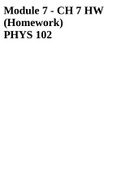
-
Module 7 - CH 7 HW (Homework) PHYS 102
- Exam (elaborations) • 8 pages • 2022
-
- $7.49
- + learn more
Module 7 - CH 7 HW (Homework) PHYS 102 AUG 2017 1) A current of 26.9 A flows through an electric heater operating on 220 V. What is the heater's resistance? Ω Current: I = 26.9 A Voltage: V = 220 V Resistance: R = ??? Ω R = V I R = 220 V 26.9 A R = 8.1784 Ω 2) A 590 Ω resistor is connected to a variable-voltage power supply. (a) What voltage is necessary to cause a current of 0.5 A in the resistor? V Current: I = 0.5 A Resistance: R = 590 Ω Voltage: V = ??? V V = R * ...

-
PHYS 102 MODULE 1- 7
- Package deal • 6 items • 2022
-
- $18.49
- 1x sold
- + learn more
Exam (elaborations) Module 7 - CH 7 HW (Homework) PHYS 102 2 Exam (elaborations) PHYS 102 Module 6 3 Exam (elaborations) PHYS 102 Module 5 HW (Homework) 4 Exam (elaborations) PHYS 102 Module 4 year 2022 5 Exam (elaborations) PHYS 102 Module 3 2022 6 Exam (elaborations) PHYS 102 Module 2 CH 2 HW (Homework) 7 Exam (elaborations) PHYS 102 WEEK 1

-
PHYS 102 Module 6
- Exam (elaborations) • 9 pages • 2022
- Available in package deal
-
- $8.49
- + learn more
1. 6.66/6.66 points | Previous Answers The force stretching the D string on a certain guitar is The string's linear mass density is What is the speed of the waves on the string? 155.99 m/s Show My Work (Optional) 2. 6.66/6.66 points | Previous Answers The coldest and hottest temperatures ever recorded in Brazil are (259 K) and (318 K), respectively. What is the speed of sound in air at each temperature? 323.48 m/s at 358.43 m/s at Show My Work (Optional) Module 6 CH 6 HW (Homework) ...
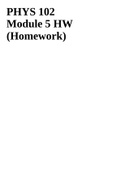
-
PHYS 102 Module 5 HW (Homework)
- Exam (elaborations) • 12 pages • 2022
- Available in package deal
-
- $8.49
- + learn more
On a nice winter day at the South Pole, the temperature rises to What is the approximate temperature in degrees Celsius? -59.4 °C Show My Work (Optional) Module 5 CH 5 HW (Homework) Valerie Hallet PHYS 102 AUG 2015 Online, section Beston, Fall 2015 Instructor: William Beston WebAssign −75°F. What steps or reasoning did you use? Your work may add bonus points towards your score. Uploaded File (10 file maximum) No Files to Display Upload File Show My Work has not been graded yet....
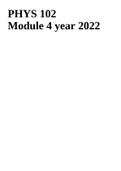
-
PHYS 102 Module 4 year 2022
- Exam (elaborations) • 13 pages • 2022
- Available in package deal
-
- $8.49
- + learn more
PHYS 102 Module 4 year 2022 PHYS 102 Module 4 year 2022 PHYS 102 Module 4 year 2022
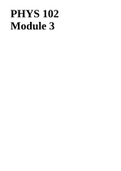
-
PHYS 102 Module 3 2022
- Exam (elaborations) • 16 pages • 2022
- Available in package deal
-
- $8.49
- + learn more
Q1 Which has the larger linear momentum: a 2,300-kg houseboat going 9 m/s or a 720-kg speedboat going 25 m/s? Step 1: Write down what you know in symbolic form: a. House boat: mhb = 2,300 kg and v hb = 9 m/s b. Speedboat: msb 720 kg and vsb = 25 m/s Step 2: Write down what you don't know in symbolic form: Momentum of the houseboat and speedboat. a. Momentum of the houseboat = ? b. Momentum of the speedboat = ? Step 3: Find an equation that contains what you know and what you don't k...
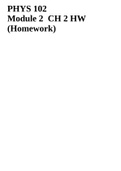
-
PHYS 102 Module 2 CH 2 HW (Homework)
- Exam (elaborations) • 7 pages • 2022
- Available in package deal
-
- $9.49
- + learn more
1. 6.66/7.14 points | Previous Answers A jet aircraft with a mass of 4,250 kg has an engine that exerts a force (thrust) equal to 60,400 N. (a) What is the jet's acceleration? (Give the magnitude.) 14.21 m/s^2 (b)What is the jet's speed after it accelerates for 7 s? (Assume it starts from rest.) 99.47 m/s (c) How far does the jet travel during the 7 s? 348.15 m Show My Work (Optional) 2. 7.14/7.14 points | Previous Answers A motorcycle and rider have a total mass equal to 330 kg. The...
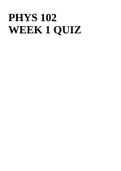
-
PHYS 102 WEEK 1 QUIZ
- Exam (elaborations) • 12 pages • 2022
- Available in package deal
-
- $8.49
- + learn more
PHYS 102 WEEK 1 QUIZ Q1 A long-distance runner has an average speed of 3 m/s during a race. How far does the runner travel in 39 minutes? Step 1: Write down what you know in symbolic form: Speed: v = 3 m/s Time: t = 39 min = 39 min x 60 s/min = 2,340 s. In physics we use the MKS system. Therefore, when solving problems your units need to be in M(meter(m))K(kilogram(kg))S(second(s)) units. Step 2: Write down what you don't know in symbolic form: How far (distance): d =? Step 3: Fin...

That summary you just bought made someone very happy. Also get paid weekly? Sell your study resources on Stuvia! Discover all about earning on Stuvia


